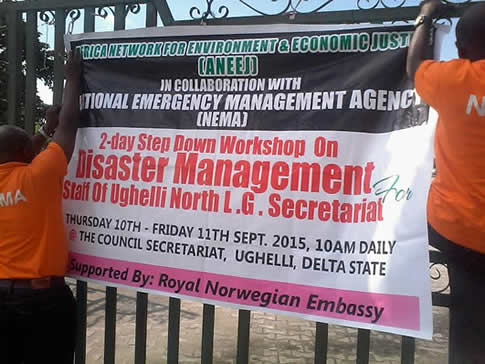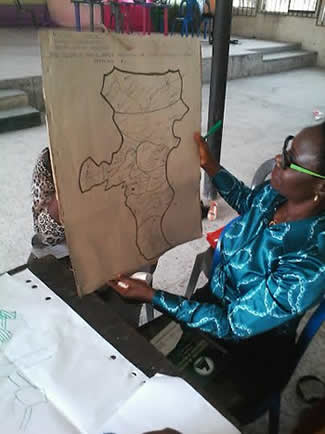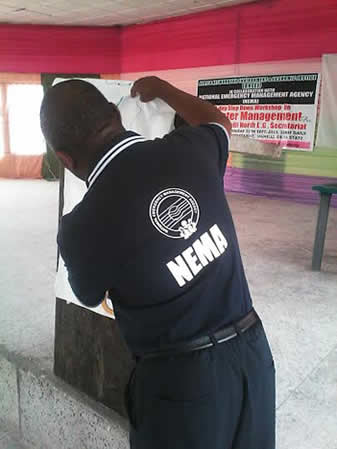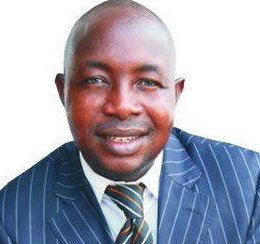This year alone, three years after the 2012 flood, the National Emergency Management Agency, NEMA, has issued nearly 3 warnings of impending floods in the Niger Delta. In one of those warnings, NEMA said that between August and November, Cameroonian authorities would release excess water from the Lagdo Dam.
By Bob MajiriOghene Etemiku
The Youth Corps member who recently walked up to me at the Ughelli North Local Government Secretariat thought that I was the right person he should approach.
But he made a mistake. He was trying to find out from me what he could do with the people who were dumping the refuse that blocked a waterway in his place of primary assignment in Agadama.
I found out from a brief interaction that he is from Imo State. He appeared filled with a strong desire to make a strong impact in his local community of service.
My guess is that he approached me because he thought that I was a NEMA official on the go: on the 10th and 11th of this month, I participated in a Disaster Management Workshop supported by the Royal Norwegian Embassy in Nigeria, which took place in a high risk area in the Delta that suffered heavy casualty from the 2012 flood disaster.
Perhaps the poor chap had approached me because he had listened to a speech I gave before the workshop wherein I had said that most natural disasters were not ‘natural’ anymore but are ‘man-made’.
But the NEMA man in charge of the South-South Zone had immediately jumped into the flood of issues arising from my seemingly outlandish comment, to say that indeed our disasters are not ‘man-made’ but ‘man-induced’.
I have no problem with his terminology – ‘induced’ or ‘man-made’ disasters are synonymous if you ask me. The basic thing we should all be worried about is that the rains are falling fast and furious, and the ground is hardly able to absorb the speed and consistency at which it rains.
We should be asking ourselves why the canals and sewage systems are unable to withstand the rains, especially in very technologically advanced places like Japan and China where the floods have wreaked havoc on cities and municipalities.
Perhaps it is at this junction that we should realize that in the face of melting ice glaciers from high temperatures, our technologies may do little or nothing to contain the coming disasters in Nigeria or elsewhere in the world.
I had a problem with how to handle the young man seeking to address an issue bordering on our overt and covert complicity in the avoidable disasters that we induce.
To summarize my interaction with this young chap so that we can move on to other issues, I asked him to use his android phone to take a photo of that blocked canal and send it to one or two of our media houses, with the hope that it might receive some attention and get some publicity. I gave that suggestion as a last resort. In 2012 after floods sacked villages and communities in the Delta and across Nigeria, the Federal and state governments fought tooth and nail to bring succor to affected communities.
Even though they brought relief materials to the displaced persons, camped them in makeshift shelters, provided food, beddings and managed to rescue quite a number of persons, yet we are still at that crossroad where a youth corps member has no idea which institutions he should approach to get a waterway cleared.
Now the question is this: in spite of all the relief materials and the effort by NEMA to provide palliatives to persons affected by floods, why are we still unprepared if the floods actually come to sack us in November?
Why are we still using temporary structures like primary and secondary schools and open fields as mass shelters for affected flood victims?
The answer to that question comes from another interaction with NEMA itself. One, the Agency is seriously under-staffed. For instance, the South-South Zonal Office domiciled in Port Harcourt, Rivers State, and which should take care of Delta, Edo, Akwa-Ibom, Rivers and Ondo States has only 26 members of staff as full-time employees.
When there are disasters or emergencies, NEMA relies more on ad-hoc staff, volunteers and a miscellaneous team of security and health personnel who fall over one another trying to be in charge.
According to a report by NEMA, planning for disaster management is usually bogged down by issues of bureaucratic bottlenecks, inadequate number of skilled SEMA personnel, absence of LEMCs, inadequate Logistic supports, lukewarm attitudes from some stakeholders, unruliness of camp residents and inadequate security of camp officials.
One of the participants at that workshop, told me in very measured tones that in some very nasty cases, this assorted army of disaster managers fights over who should be in charge of the food, beddings and medicine for the affected persons.
Another thing we should consider as the floods approach is that in nearly all the local government areas in the South-South, there are no LEMCs – Local Emergency Management Committees – to be made up of the stakeholders – ordinary people of the affected communities.
Therefore, we find ourselves saddled with a situation where everyone runs to the NEMA if a waterway is blocked in Agadama or in Iguobazuwa or in Umuofia.
Disasters and emergencies can be categorized in three – the minor, major and catastrophic, and nearly along the same lines as there are three tiers of government – the local, state and national.
We cannot be asking for NEMA if a waterway is blocked by human induced or man-made circumstances in a village in Ughelli or Oshogbo. That should be the responsibility of SEMA, working closely with the local government officials.
This year alone, three years after the 2012 flood, the National Emergency Management Agency, NEMA, has issued nearly 3 warnings of impending floods in the Niger Delta. In one of those warnings, NEMA said that between August and November, Cameroonian authorities would release excess water from the Lagdo Dam.
If we recall, the 2012 flood disaster was attributed to the release of excess water from that same dam. What the SEMA people should be doing now is set up a crack public enlightenment team in conjunction with the local authorities, to educate people in high risk flood areas.
Part III of the NEMA Act, 1999 mandates State Emergency Management Agencies, SEMAs, to create a local LEMC to respond to any disaster within the State and seek assistance from the Agency if it deems fit in each circumstance.
That part of the Act also mandates the SEMAs to carry out disaster management activities in the state as may from time to time be recommended by the Agency of the state Committee.
And indeed, why the state governments across board are unwilling to set up these local emergency committees in the face of several warnings from NEMA beats the imagination.
Information available from NEMA indicates that if there’s another flood in a state like Delta, about 14 out of the 25 Local Government Areas of the State will certainly be flooded.
It will result in the massive displacement of people coupled with destruction of property and farmlands, with more than 200 communities and about 137.1 hectares of the farmlands affected in 2012.
Yet as we speak, many state governments have done little or nothing to organize our people to be prepared, to know what to do in case these floods come.
It is a foreign government that is picking up the bills for the enlightenment campaigns on disaster management. Shame on us all.
Bob MajiriOghene Etemiku is communications manager, Africa Network for Environment & Economic Justice, ANEEJ, @DsighRobert.








